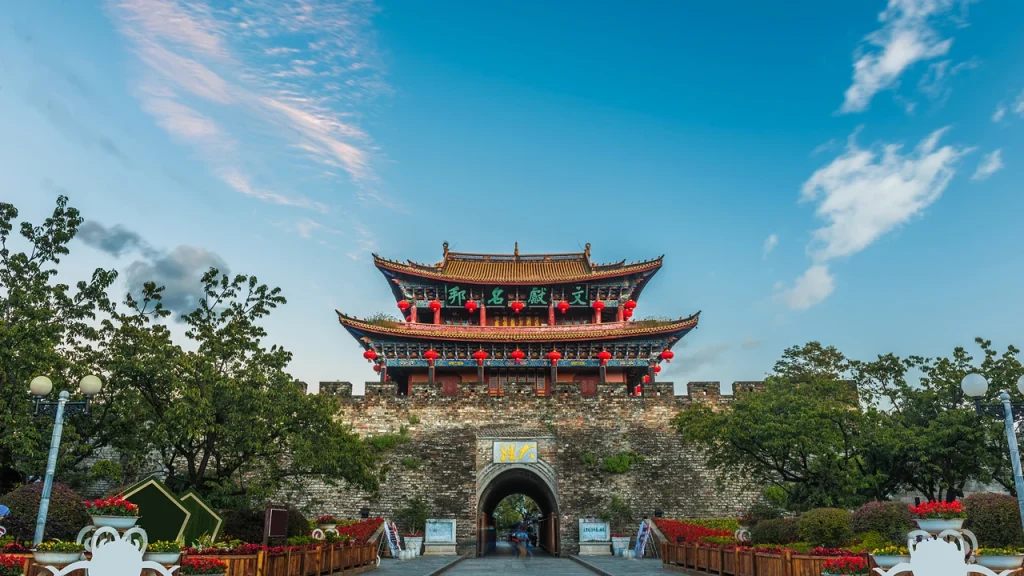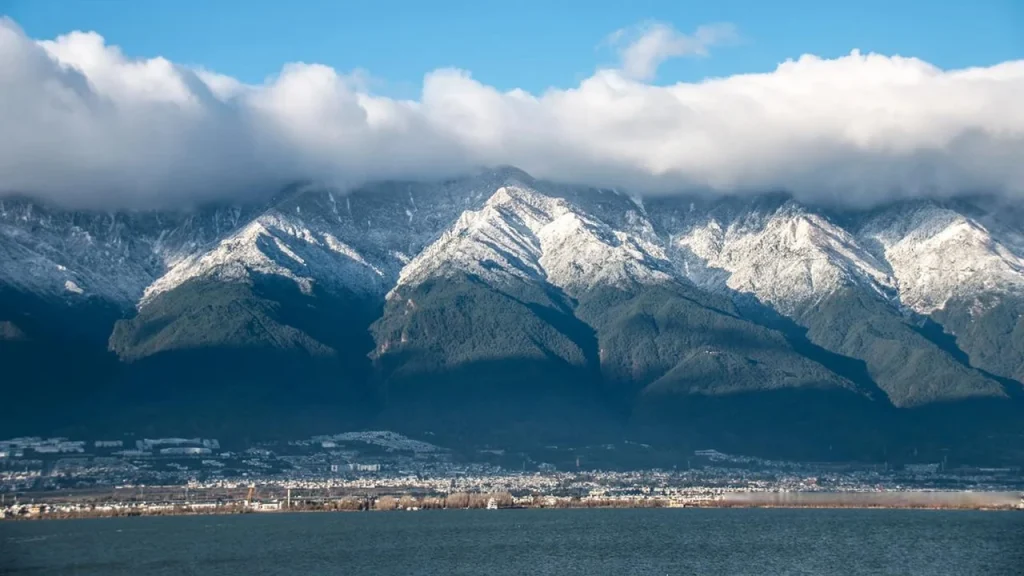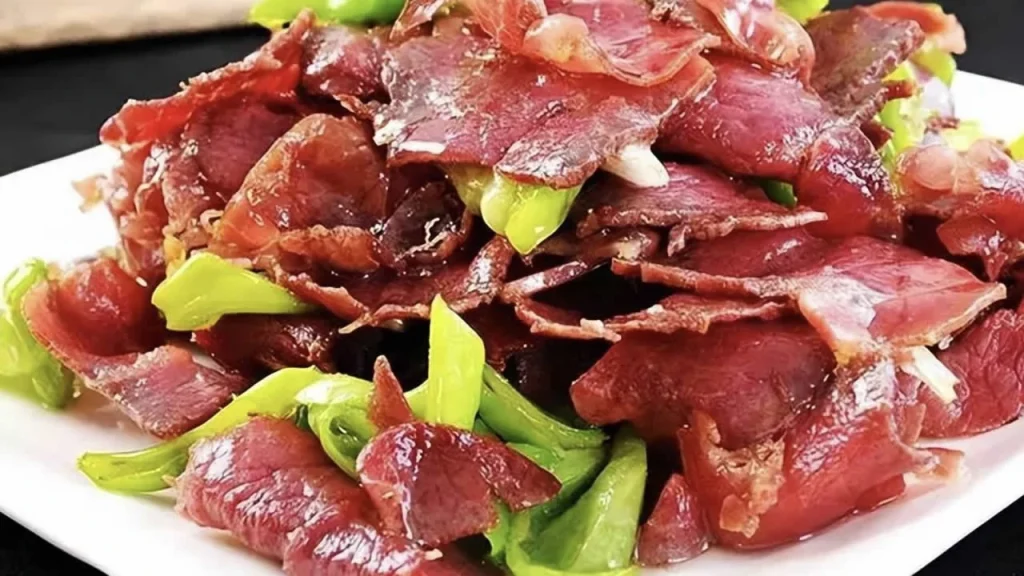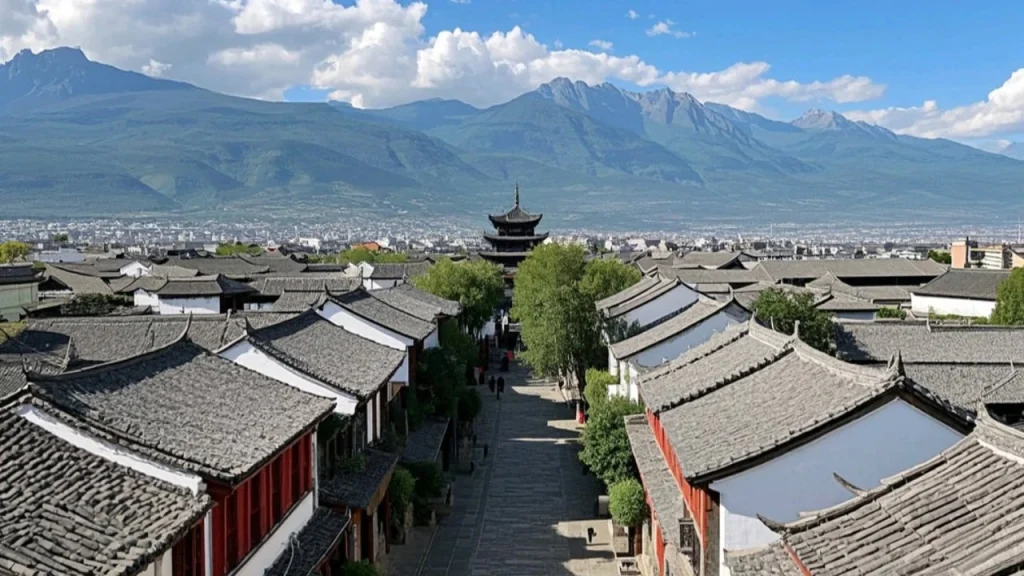Nestled in the folds of western Yunnan, there lies a city where time seems to stretch like taffy. As the morning light unfurls the mist cloaking Cangshan Mountain, and the setting sun fractures Erhai Lake’s waters into golden shards, Dali embraces its own rhythm – a thousand years of history distilled into a rose-infused elixir, waiting to surprise you at every winding alley. More than just the geographical “Crossroads of Asian Cultures,” this is an eternal utopia etched in travelers’ hearts – a tender sanctuary where souls pause to breathe.

Chapter 1: Urban Sketch: Poetic Dwelling Between Cangshan and Erhai
The Dali Bai Autonomous Prefecture, nestled at the junction of the Yunnan-Guizhou Plateau and the Hengduan Mountains, shines like a pearl cradled by the nineteen peaks of Cangshan. As China’s sole Bai autonomous prefecture, it unfurls a three-dimensional tapestry across 29,500 square kilometers, weaving together Bai tie-dye craftsmanship, the misty history of the Nanzhao Kingdom, Erhai’s moonlit waters, and Cangshan’s snow-capped vistas.
The prefecture encompasses 12 administrative regions including the pulsating heart of Dali City. Weishan County cradles the cradle of the Nanzhao Kingdom, while Jianchuan County earns acclaim for its woodcarving traditions. Heqing’s artisans imbue handcrafted silverware with human warmth, and Eryuan’s hot springs bubble with geothermal kindness. Perched at an average elevation of 2,090 meters, the region enjoys 2,200 annual sunshine hours, creating a climate where winters remain gentle and summers never scorch – even the air carries a crisp highland freshness infused with floral fragrance.
Chapter 2: Historical Tapestry: Echoes of a Millennium from Nanzhao Kingdom to “Realm of Literary Legacy”
Dali’s history unfolds as an epic inscribed in stone and scripture. As early as the 2nd century BCE, this land served as a vital relay station along the “Shu-Shendu Road” (ancient Silk Route to India). The Nanzhao and Dali kingdoms established here by Bai ancestors during the Tang-Song dynasties transformed Dali into a vital nexus between Central China and Southeast Asia. The brushstrokes of the Dali Kingdom’s Zhang Shengwen Album still whisper tales of the “Fragrant Kingdom of Buddhism,” while Ming Dynasty scholar Yang Sheng’an’s verse – “Cangshan’s unpainted scroll endures through millennia, Erhai’s unstrung zither resounds across eons” – captures the eternal poetic essence of this borderland town.

The accolade that truly propelled Dali to global recognition came in 1982, when the Ancient City of Dali was designated among China’s first National Historical and Cultural Cities. Celebrated as a “Realm of Literary Legacy,” this ancient city preserves its “Nine Streets, Eighteen Alleys” layout as a living cultural artifact. Within its walls, the Bai people’s “Three Courtyards and One Screen Wall” residences, the incense of Benzhu Temples (deity worship halls), and the bustling March Fair markets coalesce into a dynamic cultural tableau.
Chapter 3: Geographic Cipher: A Symphony of Snow Mountains and Lakes

Unfolding Dali’s geographic canvas reveals the magic of 25°N latitude:
- Cangshan Mountains: This snow-capped range stands as a colossal screen, with Malong Peak (4,122 meters) as its brushstroke inscribing heroic verses between heaven and earth. Nineteen peaks cradle eighteen streams – Qingbi, Zhonghe, Tao… Each waterway serves as a love letter from Cangshan to Erhai Lake. A cable car ascends to Xima Lake, where a 3,900-meter-high glacial lake gleams like a sapphire set atop the mountain crown.
- Erhai Lake: This plateau jewel functions as Dali’s soulful gaze. Its ear-shaped surface mirrors Cangshan’s snow, Bai dwellings’ eaves, and soaring seagulls. A lakeside bicycle journey frames postcard vignettes: Xizhou’s rice fields undulating in golden waves, Shuanglang’s lakeside guesthouses facing the sea, and Xiaoputuo Island emerging from morning mists with fishermen’s songs.
- Jizu Mountain: This sacred Buddhist peak blossoms like a lotus in Binchuan County, consecrated as a Zen holy land by the legend of Kasyapa Buddha’s robe and begging bowl. Ascending Jinding Temple at dawn, one witnesses roiling sea of clouds at sunrise and Buddha’s radiance bathing the peaks – a celestial tableau that transcends earthly bounds.
Chapter 4: Dali on the Tip of the Tongue: A Gastronomic Journey from Dairy Delights to Sour-Spicy Fish
In Dali, cuisine unfolds as a moving feast. When the milky aroma of rushan (dairy fans) mingles with the tangy freshness of sour-spicy fish, when the pillowy softness of erkuai (rice cakes) meets the crisp tenderness of raw pork skin, taste buds embark on a cross-terrain adventure spanning plateaus and river valleys.
Culinary Atlas of Must-Try Delights
- Rushan (Dairy Fans)
These fan-shaped dairy products, crafted from carabao milk, are the Bai people’s answer to cheese. Grilled to golden perfection and slathered with rose petal jam, or deep-fried and dusted with sugar, each bite delivers a symphony of crispy and tender textures, where creamy richness dances with floral fragrance.
- Sour-Spicy Fish
Erhai crucian carp cavorts with papaya and chili in this iconic dish, balancing tartness, spice, and fruity notes. The tender fish flesh bathes in a robust broth that, when paired with a cup of Bai-brewed plum wine, creates a flavor explosion that electrifies the palate.
- Erkuai (Rice Cakes)
Crafted from pounded rice, these versatile cakes adapt to any cooking method: grilled, stir-fried, or boiled. As a street food star, grilled erkuai comes slathered with chili sauce and crushed peanuts, wrapped around youtiao (fried dough) or ham sausage. Stir-fried versions mingle with fresh pork and pickled vegetables, marrying glutinous softness with wok hei (breath of the wok).

- Nuodeng Ham
Crafted in Nuodeng Village, Yunlong County, this artisanal ham undergoes a three-year curing process using salt from local wells. Sliced thin for raw consumption, its rose-hued flesh offers a harmonious blend of saltiness, savory depth, and honeyed sweetness – earning it a place among China’s “Three Great Hams” alongside Xuanwei Ham and Jinhua Ham.
- Raw Pig Skin
The crown jewel of the Bai “Eight Earthly Bowls,” this dish begins with singeing pig bristles over straw fire. The resulting crisp skin and tender meat are shredded, then dipped into a sauce of plum vinegar, chili, and Sichuan pepper. This bold culinary tradition offers a dual thrill: a test of gastronomic courage and a celebration of tangy-spicy perfection.
Culinary Hotspots
- Beimen Market: Dawn reveals Dali’s vibrant soul, where morning stalls overflow with fresh xidoufen (pea flour soup), posuba (flaky layered bread), and carved plum preserves.
- Renmin Road: By night, this pedestrian strip transforms into a foodie battleground. Favorites include “Zaihuishou” cold chicken rice noodles and “Selemu” yellow pea jelly, where lines snake into the streets.
- Shuanglang Ancient Town: Coastal restaurants pair Erhai sour-spicy fish and silver fish omelets with “Wind, Flower, Snow, Moon” craft beer – perfect accompaniments to sunset views and crashing waves.
Chapter 5: Traveler’s Bible: 100 Ways to Unlock Dali’s Charms
- Erhai Lake Circuit
Rent an e-bike or Smart car for a 120km clockwise loop around the lake. Xizhou’s rice terraces, Zhoucheng’s tie-dye workshops, Shuanglang’s sunsets, Haidong’s reefs – every kilometer unfolds a postcard view. Recommended route: Ancient City of Dali → Xizhou → Zhoucheng → Shuanglang → Xiaoputuo Island → Xiaguan.
- Cangshan Trek
Begin at the Gantong Ropeway, hike through Qingbi Creek Gorge, and discover the Jade Belt Path and Qianlong Pavilion’s “Exquisite Chessboard” rock formation. Fitness enthusiasts can tackle the Zhonghe Temple to Taoxi Creek trail, where wildflowers and babbling brooks transport you into Jin Yong’s martial arts realm.

- Timeless Moments in Shaxi Ancient Town
This former Tea-Horse Road stopover preserves caravan culture in its every cobblestone. The Ancient Stage, Yujin Bridge, and Sideng Street’s slate paths exude vintage charm. At “Cosmic Bread,” wait for freshly baked German-style sourdough while watching sunset paint caravan statues gold.
- Weishan Ancient City Roots Tour
Birthplace of the Nanzhao Kingdom, this town retains more authentic character than its namesake city. Gaze at starry skies from Gongchen Tower, admire ancient cypresses at Wenhua Academy, and savor cross-river erkuai noodles at Lao Wang’s – transporting you instantly to antiquity. Don’t miss the Yi Ancestor Worship Festival (lunar February 8), where thousands dance the explosive “Zhaojue” dance.
- Jizu Mountain Pilgrimage
From Zhusheng Temple at the foothills to Jinding Temple at the summit, 3,000 steps test pilgrims’ devotion. At Huashou Gate, hear the legend of Kasyapa’s meditation; at Jinding Temple, await sunrise over seas of clouds as Buddha’s aura manifests before your eyes.
Chapter 6: Dali’s Climatic Code: Gifts of the Plateau Monsoon
Dali enjoys a low-latitude plateau monsoon climate, marked by minimal annual temperature variation but significant day-night fluctuations. Winter (Nov-Feb) brings crisp sunny days – ideal for viewing Cangshan’s snow-capped peaks. Spring (Mar-May) erupts in wildflower displays, with Eryuan’s Pear Garden Village blanketed in snow-white blossoms. Summer (Jun-Aug) brings rain showers, though post-storm Cangshan often rewards with rainbows while Erhai’s Potamogeton lucens (sea blossom) bloom like starry constellations. Autumn (Sep-Oct) offers crystalline skies and exceptionally luminous moonlit nights over the lake.
Travel Tips:
- Sun protection is non-negotiable year-round. The plateau’s intense UV rays demand sunglasses, sunscreen, and wide-brimmed hats.
- Rain gear proves essential during monsoon season, while winter visitors should pack down jackets.
Epilogue: Dali, an Unfinished Dream
As the last sunset hues paint the Three Pagodas’ spires, and “Destination: Dali” echoes from Renmin Road bars, this city works its rhythmic magic – transforming every transient into a returning soul. Here, time isn’t a fleeting river but frozen amber, preserving Bai dwelling carvings, Erhai’s shimmering waves, and the milky fragrance of rushan dairy fans in eternal suspension.

Leave a Reply